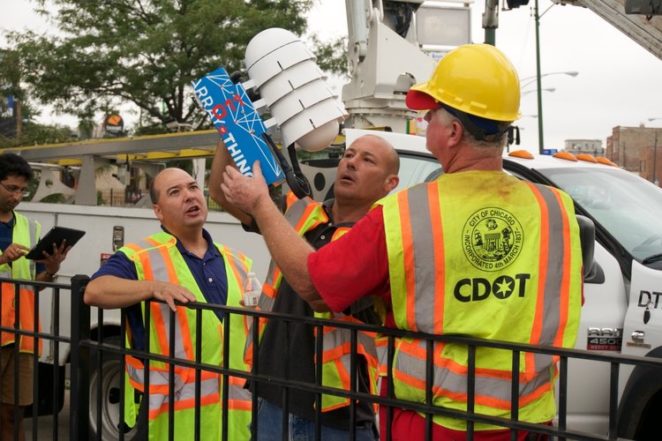
How well does “The City That Works” actually work? For that matter, how well does any city really work nowadays? How do we measure that performance, and where do we gather the data?
Those are just some of the big questions that will be investigated this fall by the Array of Things (AoT) project, an urban sensing network that will serve as a fitness tracker for the city. Ultimately drawing on 500 AoT nodes deployed throughout the city, a multi-disciplinary team of researchers will collect data on Chicago’s infrastructure, environment, population, and patterns, aiming to develop scientific solutions to urban challenges like flooding, air quality, and traffic congestion. The goal of this community technology platform is to help make cities cleaner, healthier, and more livable, says team leader Charlie Catlett, director of the Urban Center for Computation and Data at Argonne National Laboratory and the University of Chicago. Together, those two entities make up the Computation Institute , which is working jointly on the AoT project, along with the School of the Art Institute of Chicago, Northern Illinois University, and the University of Illinois at Urbana-Champaign.
Last September, the project, a first in the U.S., was awarded a $3.1 million grant by the National Science Foundation. In late August, crews began deploying 500 interactive modular sensors across the Chicago metro area to collect “big data” on the vast range of ingredients that make up the modern urban soup. The aim is to detect and monitor potential problems involving pedestrian and vehicular traffic, noise, nitrogen oxide, carbon monoxide, ozone, hydrogen sulfide and sulfur dioxide, in addition to environmental conditions ranging from barometric pressure to air temperature to light intensity.
Field installations start
The “smart city” initiative kicked off when city workers affixed a pair of 10-lb sensors, encased in beehive like enclosures, to light poles in Chicago’s Pilsen neighborhood, where air quality and high asthma levels are of particular concern. Before year’s end, 50 sensors will be installed on city light poles, with the remaining 450 due to come online across the city by 2018.
As planned, the AoT team will collaborate with the city’s Dept. of Innovation and Technology (DoIT!) and the Chicago Dept. of Transportation (CDOT), as well as researchers, and neighborhood and community leaders, to identify the most desirable locations for the sensors. “Five years out, if we’re successful, this data and the applications and tools that grow out of it will be embedded in the lives of residents, and the way the city builds new services and policies,” Chicago CIO Brenna Berman told reporters.

Meantime, data collected by the sensors will be made available to the public on the Chicago’s open-data network by mid-October, allowing residents to use the information to inform day-to-day decision making. For instance, according to the AoT website:
“Sensors monitoring air quality sound and vibration (to detect heavy vehicle traffic) and temperature can be used to suggest the healthiest and unhealthiest walking times and routes through the city… Real-time detection of urban flooding can improve city services and infrastructure to measurements to prevent property damage.”
Given varying climatic conditions throughout the city, residents also will have access to “measurement of micro-climate in different areas of the city, so they can get up-to-date, high-resolution ‘block-by-block’ weather and climate information,” according to AoT.
The underlying software and hardware uses the Waggle sensor platform, designed by Catlett, Pete Beckman, and Rajesh Sankaran. The node enclosures were designed and manufactured by Product Development Technologies in Lake Zurich IL, from original designs by Douglas Pancoast and Satya Mark Basu of the School of the Art Institute. AT&T is the project’s communications connectivity partner.
The project also draws on help from industry partners who provided in-kind engineering expertise, including Cisco, Intel, Microsoft, Motorola Solutions, Schneider Electric, and Zebra Technologies.
Similar projects reportedly are now in the works for more than a dozen additional U.S. cities, including Atlanta, Chattanooga, and Seattle.

Discussion
Be the first to leave a comment.
You must be a member of the BuiltWorlds community to join the discussion.